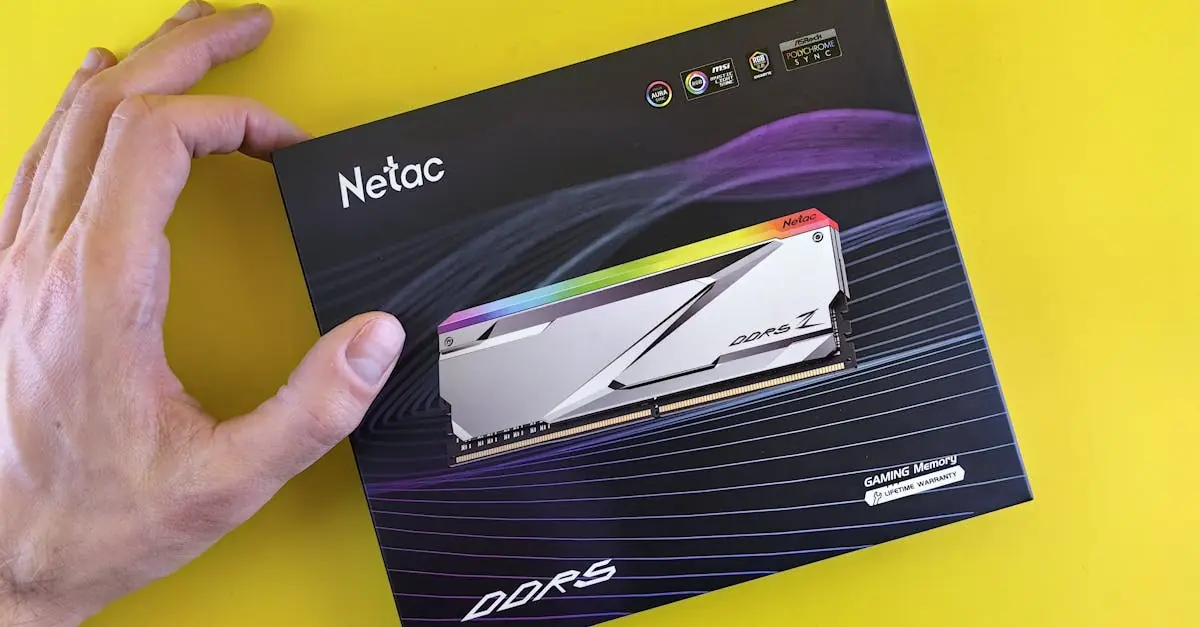In the ever-evolving world of tech, RAM is like the unsung hero of your computer. It’s the trusty sidekick that keeps everything running smoothly while you binge-watch cat videos or conquer virtual empires. But with DDR4 and DDR5 battling it out for supremacy, choosing the right RAM can feel like deciding between pizza and tacos—tough but crucial.
DDR4 has been a reliable companion for gamers and professionals alike, but DDR5 is strutting in with promises of faster speeds and improved performance. It’s like upgrading from a trusty old bicycle to a sleek sports car. So, which one should you hitch your wagon to? Buckle up as we dive into the nitty-gritty of DDR4 vs DDR5 RAM, exploring their differences and helping you make the smartest choice for your setup.
Table of Contents
ToggleOverview of DDR4 and DDR5 RAM
DDR4 and DDR5 RAM represent significant advancements in memory technology. DDR4, launched in 2014, offers speeds ranging from 1600 MT/s to 3200 MT/s. This type of RAM has become the standard for gaming and productivity tasks, providing stability and efficiency.
Contrastingly, DDR5 emerged in 2020, showcasing speeds from 4800 MT/s to 8400 MT/s. Performance expectations reflect DDR5’s architecture, which supports larger data transfers and increased bandwidth. Users benefit from higher efficiency, with improvements in power management.
Latency impacts both DDR4 and DDR5. DDR4 typically operates with a CAS latency of 15 to 20. DDR5, while addressing speed, may exhibit slightly higher latency, ranging from 30 to 40. This aspect often raises questions about real-world implications, especially for gamers and professionals requiring responsive systems.
Compatibility varies significantly. DDR4 modules cannot integrate into DDR5 slots, highlighting the importance of motherboard support. Current setups may not support DDR5 without an upgrade, while DDR4 remains widely compatible with older systems.
Pricing plays a crucial role in decision-making. DDR4 is generally more cost-effective due to its established presence in the market. Conversely, DDR5, being newer and more advanced, tends to carry a premium price tag.
Power consumption also differs. DDR4 operates at 1.2 volts, whereas DDR5 reduces power draw to around 1.1 volts. This reduction leads to lower energy costs for systems that prioritize performance and efficiency.
Assessing these aspects helps users determine the best memory choice for their needs. DDR4 ensures reliability, while DDR5 offers future-proofing and higher speeds. Making an informed decision requires considering specific performance needs and system compatibility.
Key Differences Between DDR4 and DDR5 RAM
Understanding the key differences between DDR4 and DDR5 RAM provides clarity for users making decisions about memory for their systems.
Speed and Frequency
DDR4 RAM offers speeds ranging from 1600 MT/s to 3200 MT/s. In contrast, DDR5 significantly enhances performance with speeds between 4800 MT/s and 8400 MT/s. Increased speed facilitates faster data processing, which benefits tasks such as gaming, video editing, and 3D rendering. Consequently, users looking for superior performance should gravitate towards DDR5. Upgrading to this newer RAM type leads to improved efficiency and responsiveness in demanding applications.
Latency
Typically, DDR4 exhibits a CAS latency between 15 and 20. DDR5, meanwhile, has a higher latency of around 30 to 40. While higher latency may raise concerns for some users, the overall performance gains in speed frequently outweigh this drawback. It’s essential to consider specific use cases—many applications are designed to take advantage of increased bandwidth and speed, which can reduce the impact of latency. Users focused on specific tasks may find the performance benefits of DDR5 suitable even with its higher latency.
Bandwidth
DDR4 provides a bandwidth of up to 25.6 GB/s, sufficient for standard computing and gaming needs. DDR5, on the other hand, dramatically increases this with bandwidth reaching 51.2 GB/s. Enhanced bandwidth supports more data transfers simultaneously, making it ideal for multitasking and memory-intensive applications. Users involved in tasks requiring high data throughput, such as cloud computing or heavy gaming, often benefit from this upgrade. High bandwidth leads to smoother performance and improved user experience in demanding environments.
Performance Comparison
Performance directly affects user experience in various computing tasks. DDR4 and DDR5 RAM showcase specific advantages depending on their applications.
Gaming Performance
Gaming performance significantly benefits from DDR5’s increased speed and bandwidth. Data transfer rates of up to 51.2 GB/s provide smoother gameplay and reduced stuttering. Gamers experience faster loading times, which enhances immersion. DDR4 remains a solid choice for standard gaming, delivering speeds up to 25.6 GB/s that handle most titles effectively. However, advanced games designed for high-resolution settings often exploit the superior capabilities of DDR5. Optimal performance in competitive gaming becomes even more crucial, making the enhanced features of DDR5 appealing to serious gamers.
Productivity and Multitasking
Productivity tasks see considerable improvements with DDR5 RAM, particularly in multitasking environments. Faster speeds allow applications to access data more quickly, boosting overall efficiency. Creative professionals can run demanding software like video editing programs with minimal lag. DDR4 performs sufficiently for everyday tasks such as word processing and web browsing, providing stable performance. Users requiring high-speed processing for intensive workloads benefit directly from DDR5’s increased bandwidth. Consequently, power users and content creators often find DDR5 advantageous for managing multiple tasks seamlessly.
Compatibility and Pricing
Compatibility plays a significant role when choosing between DDR4 and DDR5 RAM. Motherboards designed for DDR4 cannot accommodate DDR5 modules, which means users must verify their motherboard specifications before upgrading. Upgrading to DDR5 typically requires a compatible motherboard that supports this newer technology, ensuring optimal performance.
Cost considerations also impact RAM selection. DDR4 tends to be more affordable due to its established presence in the market, making it a practical choice for budget-conscious users. DDR5 commands a premium price owing to its advanced features and higher speeds. As DDR5 technology continues to evolve, prices may decrease over time, but currently, users should expect to pay more for the benefits DDR5 offers.
Choosing between DDR4 and DDR5 RAM ultimately depends on individual needs and budget. For gamers and professionals seeking reliable performance without breaking the bank, DDR4 remains a solid option. Its stability and efficiency make it suitable for a wide range of tasks.
On the other hand, those looking for cutting-edge performance and faster speeds may find DDR5 to be worth the investment. With its higher bandwidth and improved power management, DDR5 is ideal for multitasking and demanding applications.
As technology advances, understanding these differences will help users make informed decisions that align with their performance requirements and future-proof their systems.




